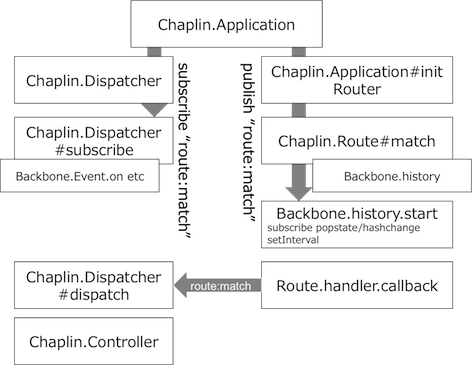Chaplinjsで渡されるroutesについて、イベントのpub/subの挙動を真面目に読んでいなかったところを読んだのでまとめました。
端的にいうと、イベント(route:match)をpublishするための登録フロー(Router -> Route -> Backbone.history)とsubscribeするための登録フロー(Dispatcher -> Route)があり、監視されているURLの変更(popstateやhashchangeなど)でイベントが発火 -> Controllerのロードとactionの実行、になっています。
Application
Applicationは内部で下記のinitを実行します。
* initDispatcher
* initLayout
* initMediator
* initRouter
publishのフロー
initRouter
initRouterの中ではApplicationに渡されたroutesとoptionsを受け取ります
@router = new Router options
として、routerを初期化し、Router#matchというメソッドを受け、渡されたroutesを実行します。
routesは下記のようにpatternとtarget(に加え必要であればoptions)を受け、URLの変更に対して適切なControllerのactionを対応付けます。
initRouterの中では
routes? @router.match
が実行され、それぞれのmatch pattern, targetが実行されます。
matchでは、
route = new Route pattern, controller, action, options
として、routeオブジェクトが作成され、その後
Backbone.history.handlers.push {route, callback: route.handler}
としてhistory handlerに登録されます。
最後にrouteが返却されますが、routesの中では特になにも処理されていません。
routesの中で記述したルーティングが処理される機会は、このinitRouterだけになります。
Backbone.history
では、このルーティングはどのように制御されているかというと、すべてはBackbone.historyの中だけで処理されます。
Backbone.historyは、startメソッドが実行されると、hashChangeだけなのか、pushStateを見るのか、などのフラグ判別の処理の末、
if (this._hasPushState) {
addEventListener('popstate', this.checkUrl, false);
} else if (this._wantsHashChange && this._hasHashChange && !this.iframe) {
addEventListener('hashchange', this.checkUrl, false);
} else if (this._wantsHashChange) {
this._checkUrlInterval = setInterval(this.checkUrl, this.interval);
}
というように、
- popstate
- hashchange
- setInterval の3つの方法でURL変化の監視が開始されます。
URLの変化に対してhistory.checkUrlが実行されます。
この中で、setIntervalに対応するために実際にURLが変化しているかどうかのチェックが行われ、通過すると、history.loadUrlが実行されます。
Backbone.history.loadUrl
ここでようやく、Backbone.history.handlersに登録しておいたrouteが評価されます。
return _.any(this.handlers, function(handler) {
if (handler.route.test(fragment)) {
handler.callback(fragment);
return true;
}
});
handlersの中から、現在のfragment(ざっくりURL)にマッチするものが存在するかがRoute#testでチェックされ、マッチしたcallbackが実行される、という挙動になります。
ここでのcallbackは、前述のとおり、Chaplin.RouterでBackbone.history.handlers.push {route, callback: route.handler}として登録されています。
Chaplin.Route#handlerでのイベントpublish
さて、Route#handlerはどうなっているでしょうか?
例えば /users/33/posts/123?fields=comments のような fragment が渡されると、query も含めてパースされ最終的には
routes = {path, @action, @controller, @name, query}
というオブジェクトをつけて
@publishEvent 'router:match', route, actionParams, options
として、イベントが発行されます。
subscribeのフロー
Chaplin.Dispatcher
Chaplin.Dispatcherは初期化時にroute:matchイベントを@dispatchで待ち受けます。
もろもろのチェックが通ると、Dispatcher#loadController(name, handler)が発火します。
loadControllerでは、ついに動的なcontrollerのロードが行われます。
Applicationの初期化時にoptionsで渡したcontrollerSuffixやcontrollerPathが加味され、controllerのファイルパスが作成されます。
ここでのhandlerは
(Controller) =>
@controllerLoaded route, params, options, Controller
となっており、ロードされたコントローラに対して、ルーティングの結果得られたパラメタなどが渡されます。
loadControllerの中では、作成されたファイルパスに対して、define.amdまたはrequireでcontrollerモジュールが呼び出されhandler(というかcontrollerLoaded)が実行されます。
Dispatcher#controllerLoadedとDispatcher#executeAction
その後は、controllerLoadedでControllerのインスタンスが作成され、executeActionに引き渡され、その中でactionが実行される事になります。
そこで、ようやく各種のControllerで定義したメソッドのところに届くことになります
class SomeController extends Chaplin.Controller
someAction: (params, routes, options)->
まとめ
長くなりましたが、順序としては
- Applicationの初期化
- subscribe処理
-
route:matchのsubscribe - イベント受け取り時の
route, params, optionsを元に、動的にcontrollerのロード/インスタンス化/Controller#Actionの実行
-
- publish処理
- Application#initRouter
- routes(Router#match)により、Backbone.history.handlersへの追加
- Backbone.history.startによるURL変化の監視
- handlers内のmatchするhandlerのcallbackの実行
- Route#handlerでの
route:matchイベントのpublish
となっていることを読み解きました。
